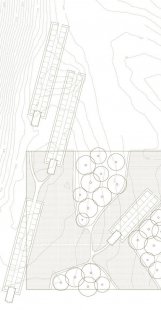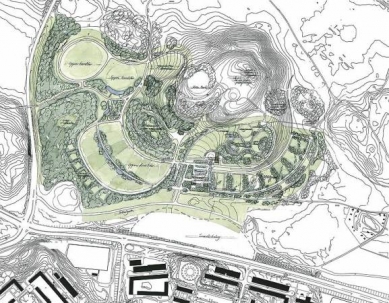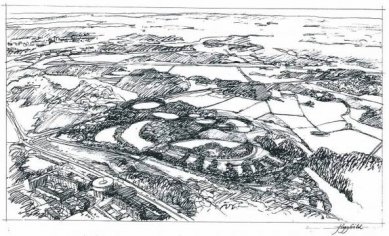
Winning project of the new cemetery in Stockholm
To the northwest of the Swedish capital lies the natural area of Järvafältet, where a new cemetery is supposed to be established on a 42-hectare site in the coming years. Specifically, it concerns the area between Hjulstakorset, Granholmstoppen, and the urban districts of Tensta, Hjulsta, and Akalla.
The winning design for the cemetery emerged from a two-round international competition, in which the jury selected from 111 projects submitted mainly by landscape architects. According to the jury, 'Öarna' is “a very beautiful and empathetic design” that gives the place character and identity as a cemetery. The judges were also excited about the project's sensitivity, artistic approach, humility towards the site, and trust in further development.
1st prize: Öarna - Kristine Jensens, Poul Ingemann
2nd prize: Skogsbrynets gräns - Topotek 1 (Martin Rein-Cano, Lorenz Dexler)
3rd prize: Growth Renewal Decay - Landskapslaget (Mikael Johansson, Linda Teng, Julia Ternström)
3rd prize: Björksalar - Jöran Bellman
More information >
The new cemetery of Järväfältet will become a modern place to rest. The burial sites will be a part of a modern cultural patchwork landscape, as an evident and natural part of a recreational site in the center of a multiethnic part of Stockholm. The ambition is to add high architectural and artistic value to the area, to create a strong identity of place. In order to contribute to a sense of community for residents as well as everybody else who makes their way to the coming cemetery and the surrounding landscape. Archaeological finds, new residual landscapes, and recreational areas will, alongside a variety of burial customs and types, create integration in time and space. In between cultural expressions and traditions – new, as well as old ones.
The botanical and cultural diversity of the existing landscape is a unique story of cultural landscaping. The history of this landscape, and the dynamic development processes, will be made a valid part of the new identity. This proposal identifies the value of a landscape which has never been consciously shaped or configured but has developed slowly over time – a collage of functions and characters. Instead of changing the landscape into a symbolically charged cemetery, the existing landscape is perceived as what one could call a ‘ready-made’, complete with stories of its own and yet free to be complemented with new stories.
The new cemetery is to be completed in stages over a long period of time. To simplify this process, all burial sites are arranged in small autonomous units. Individual islands of burial places in the changing landscapes. All burial units are produced with care for variation, environment, and durability. It is proposed that the individual units can be developed separately and specifically for each location. Also, in a multicultural discourse, the individual units can accommodate different symbolic values and expressions. It is this variation which creates a modern cemetery.
The international competition was offered by the Municipality of Stockholm in October 2009. The future cemetery in Järvafältet northwest of Stockholm is an investment of the same strategic significance which signifies the initiation of the famous Skogkyrkogården – a cemetery just south of Stockholm. A similar international competition was held 100 years ago and the winning project by Gunnar Asplund and Sigurd Lewerenz has since been the outline for the long-term development of Skogskyrkogården, now on the UNESCO World Heritage List.
The winning design for the cemetery emerged from a two-round international competition, in which the jury selected from 111 projects submitted mainly by landscape architects. According to the jury, 'Öarna' is “a very beautiful and empathetic design” that gives the place character and identity as a cemetery. The judges were also excited about the project's sensitivity, artistic approach, humility towards the site, and trust in further development.
1st prize: Öarna - Kristine Jensens, Poul Ingemann
2nd prize: Skogsbrynets gräns - Topotek 1 (Martin Rein-Cano, Lorenz Dexler)
3rd prize: Growth Renewal Decay - Landskapslaget (Mikael Johansson, Linda Teng, Julia Ternström)
3rd prize: Björksalar - Jöran Bellman
More information >
The new cemetery of Järväfältet will become a modern place to rest. The burial sites will be a part of a modern cultural patchwork landscape, as an evident and natural part of a recreational site in the center of a multiethnic part of Stockholm. The ambition is to add high architectural and artistic value to the area, to create a strong identity of place. In order to contribute to a sense of community for residents as well as everybody else who makes their way to the coming cemetery and the surrounding landscape. Archaeological finds, new residual landscapes, and recreational areas will, alongside a variety of burial customs and types, create integration in time and space. In between cultural expressions and traditions – new, as well as old ones.
The botanical and cultural diversity of the existing landscape is a unique story of cultural landscaping. The history of this landscape, and the dynamic development processes, will be made a valid part of the new identity. This proposal identifies the value of a landscape which has never been consciously shaped or configured but has developed slowly over time – a collage of functions and characters. Instead of changing the landscape into a symbolically charged cemetery, the existing landscape is perceived as what one could call a ‘ready-made’, complete with stories of its own and yet free to be complemented with new stories.
The new cemetery is to be completed in stages over a long period of time. To simplify this process, all burial sites are arranged in small autonomous units. Individual islands of burial places in the changing landscapes. All burial units are produced with care for variation, environment, and durability. It is proposed that the individual units can be developed separately and specifically for each location. Also, in a multicultural discourse, the individual units can accommodate different symbolic values and expressions. It is this variation which creates a modern cemetery.
The international competition was offered by the Municipality of Stockholm in October 2009. The future cemetery in Järvafältet northwest of Stockholm is an investment of the same strategic significance which signifies the initiation of the famous Skogkyrkogården – a cemetery just south of Stockholm. A similar international competition was held 100 years ago and the winning project by Gunnar Asplund and Sigurd Lewerenz has since been the outline for the long-term development of Skogskyrkogården, now on the UNESCO World Heritage List.
The English translation is powered by AI tool. Switch to Czech to view the original text source.
















1 comment
add comment
Subject
Author
Date
Öarna,
Vích
20.09.10 04:51
show all comments











